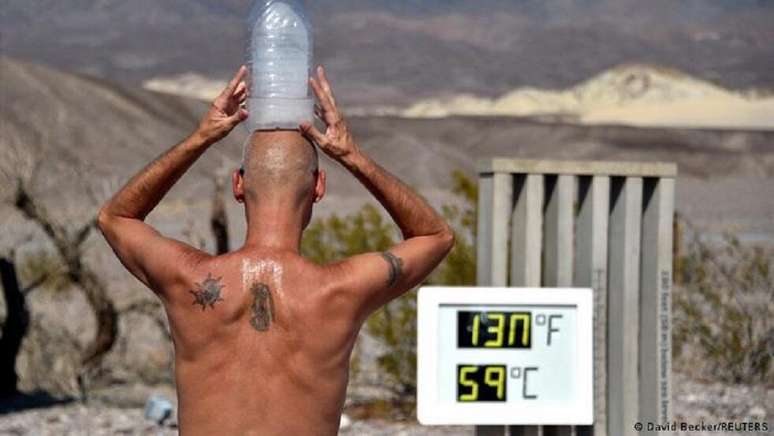The study shows that extreme heat-related deaths of older adults have increased 85% since the 1990s.
The number of people managing the The risk of dying from the effects of extreme heat could increase fivefold in the coming decades, warns a report published on November 15, 2023.
Heat-related deaths are expected to increase fivefold by 2050, study shows (Photo: David Becker-Reuters)
“The health of humanity is in grave danger,” say the authors of the fundamental research, prepared collaboratively by 114 scientists from 52 research centers and United Nations agencies around the world, and which is published every year by the scientific journal The Lancet.
The 2023 study says that, under a scenario of an average temperature increase of 2°C above pre-industrial times by the end of the century, heat-related deaths could increase 4.7 times by 2050.
The report is published two weeks before the start of the UN climate meeting COP28 in Dubsaiwith a scheduled start of November 30th, and which one for the first time there will be sessions dedicated to health.
The study highlights that, on average, the planet’s inhabitants were exposed to 86 days of potentially deadly temperatures in 2022 and that the number of people over 65 who died due to heat increased by 85% in the period 2013-2022 compared to 1991-2000. Germany alone has recorded 3,000 heat-related deaths this year.
The hottest year in history
According to estimates, 2023 will be the hottest year recorded in human history. Last week, the Copernicus Climate Change Service (C3S), a body of the European Union (EU), declared that October was the warmest month on record so far.
The effects are currently being felt in the Southern Hemisphere. Rio de Janeiro recorded on Tuesday (14/11) a thermal sensation of 58.5 °C in the west of the city, the highest since the municipal meteorological service Alerta Rio began to monitor this parameter.
“The effects currently observed may only be an early symptom of a very dangerous futureo,” said Marina Romanello, executive director of the study published in The Lancet.
In the document, the Scientists point out that heat is just one of the climatic factors that can contribute to increased mortality. Nearly 520 million more people are projected to still face moderate or severe food insecurity between 2041 and 2060 due to climate change.
And mosquito-borne infectious diseases are expected to continue to spread. Dengue transmission, for example, could increase by 36%.
UN Secretary-General António Guterres commented on the report and said that “humanity faces an intolerable future”. “We are already witnessing a catastrophe unfolding for the health and livelihoods of billions of people around the world, threatened by record heat waves, crop-devastating droughts, rising levels of hunger, growing infectious disease epidemics, deadly storms and floods,” he said. he said in a statement.
“The step of the turtle”
The UN also warned this on Tuesday governments around the world are moving forward at a snail’s pace with its commitments to reduce emissions to try to stop climate change.
In a message due to the release of the latest report on national contributions to the Paris Agreement to limit global temperature rise, UN Climate Change Executive Secretary Simon Stiell said the findings show that Countries need to take more ambitious measures at COP28 in Dubai.
“We will have to rebuild trust in the Paris process. This means honoring all commitments, and in particular the financial ones,” Stiell stressed.
The report released Wednesday 11/15 says proposed national commitments to address the climate crisis would reduce global pollutant emissions by 2% by 2030 compared to 2019 levels.
However, to achieve the goal of the Paris Agreement of limit warming to 1.5°C above pre-industrial levels – when most scientists estimate that environmental disasters such as extreme heat waves or floods will become much more intense and common, a 43% reduction would be needed.
Record concentration of greenhouse gases
On Wednesday the 15th the UN also underlined that the concentration of greenhouse gases in the atmosphere is responsible climate changebroke a record in 2022, in an upward trend that does not appear to be changing.
Last year, global average concentrations of carbon dioxide (CO2), the major greenhouse gas, exceeded pre-industrial values by 50% for the first time.
According to the World Meteorological Organization’s (WMO) annual greenhouse gas bulletin, levels continued to increase in 2023.
To the Methane concentrations and nitrogen oxide levels also set records in 2022with the most significant annual increase ever observed.
“Despite decades of warnings from the scientific community (…) we are following the wrong path,” said WMO Secretary General Petteri Taalas.
“The current level of concentrations of greenhouse gases leads us to a rise in temperatures well above the goals of the Paris Agreement by the end of the century,” he warned.
“To the Weather conditions will become more extreme: intense heat and severe storms, melting glaciers, rising sea levels, and warming and acidifying the oceans. Thus we will observe a significant increase in socio-economic and environmental costs,” added the WMO Secretary General.
This content is a work originally published by the German agency DW. The opinion expressed by the publication does not reflect or represent the opinion of this portal or its collaborators.
Source: Terra
Rose James is a Gossipify movie and series reviewer known for her in-depth analysis and unique perspective on the latest releases. With a background in film studies, she provides engaging and informative reviews, and keeps readers up to date with industry trends and emerging talents.







